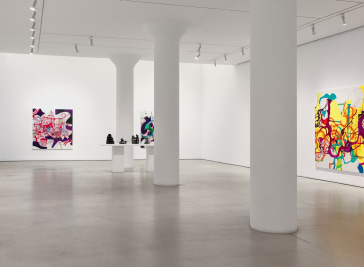
JOANNE GREENBAUM
Untitled
2024
Flashe, acrylic, oil, and marker on canvas
65 by 60 in. 165.1 by 152.4 cm.
JOANNE GREENBAUM
Untitled
2023
Oil, acrylic and marker on canvas
40 by 30 in. 101.6 by 76.2 cm.
JOANNE GREENBAUM
Untitled
2023
Acrylic, oil, and marker on canvas
72 by 70 in. 182.9 by 177.8 cm.
JOANNE GREENBAUM
Untitled
2021
Oil, flashe, acrylic and marker on canvas
70 1/8 by 60 1/4 in. 178.1 by 153 cm.
JOANNE GREENBAUM
Untitled
2022
Ballpoint pen on paper
19 7/8 by 14 1/2 in. 50.5 by 36.8 cm.
JOANNE GREENBAUM
Untitled
2022
Gouache on paper
21 5/8 by 14 1/8 in. 54.9 by 35.9 cm.
JOANNE GREENBAUM
Untitled
2024
Metallic low-fire glaze on terracotta
9 1/2 by 10 1/4 by 10 3/4 in. 24.1 by 26 by 27.3 cm.
JOANNE GREENBAUM
Untitled
2024
Metallic low-fire glaze on terracotta
13 1/2 by 12 by 5 3/4 in. 34.3 by 30.5 by 14.6 cm.
b. 1953, New York, NY
Lives and works in New York, NY
Through her use of vibrant color and intuitive composition, Joanne Greenbaum’s work achieves balance through the unconventional layering of forms in a complex pictorial space. A desire for continual reinvention serves as the motivating force behind her distinctive and immediately recognizable paintings, works on paper and ceramics. Often using drawing as the springboard for her paintings, Greenbaum formulates a vital relationship between the two approaches which ultimately reflects her own unique vocabulary of line and volume. Her ceramic sculptures follow a similar path in clay- building structures which lead to surprising and highly inventive forms.
Joanne Greenbaum earned a BA from Bard College, Annandale-on-Hudson, NY. Over the past twenty years, Joanne Greenbaum has exhibited widely at international venues including at the Nerman Museum of Contemporary Art, Overland Park, KS; Kunsthalle Dusseldorf, Germany; and MoMA PS1, New York, among many others. In 2008, a career-spanning survey of her work was mounted by Haus Konstruktiv in Zurich, Switzerland and travelled to the Museum Abteiberg in Monchengladbach, Germany. In 2018, the Tufts University Art Galleries at the School of the Museum of Fine Arts in Boston mounted “Joanne Greenbaum: Things We Said Today,” a comprehensive solo exhibition that travelled to the Otis College of Art and Design in Los Angeles.
Greenbaum is the recipient of numerous awards and fellowships, including The Gwendolyn Knight Lawrence Award from the Academy of Arts and Letters, New York; the Joan Mitchell Foundation Grant; Artist in Residence at The Chinati Foundation, Marfa, TX; The Pollock-Krasner Foundation Grant and the John Simon Guggenheim Memorial Foundation Grant. Her work is included in the collections of the Brandeis Rose Art Museum, Waltham, MA; CCA Andratx, Majorca, Spain; Hammer Museum, Los Angeles; Haus Konstruktiv Museum, Zurich; Herbert F. Johnson Museum of Art at Cornell University, Ithaca, NY; Museum Abteiberg, Monchengladbach, Germany; Museum of Fine Arts, Boston; the Nerman Museum of Contemporary Art, Overland Park, KS and the Ross Art Collection at the University of Michigan, Ann Arbor, MI.
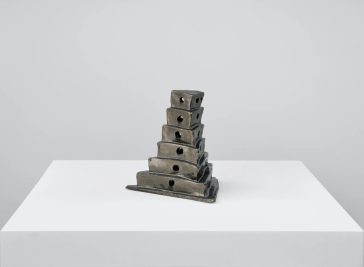
By refusing to pursue the pictorial, geometric, or gestural, or pick up where the Pattern and Decoration movement left off, while committing to drawing in paint, Greenbaum distinguishes her work from that of many of her peers. Fiercely independent, she belongs to no group, movement, or style; I have long admired her determination to make work without allusions to other artists, tropes (e.g., grids, parody, citation), or a shared experience. This is her clarion call for artistic freedom, and it made me excited to see Scaffold, her debut exhibition at Mitchell-Innes & Nash. Greenbaum paints incrementally, discovering her composition as she proceeds. In a nearly square untitled work from 2024, red lines, ragged-edged swaths of turquoise, and angular maroon shapes sit atop a pink ground.
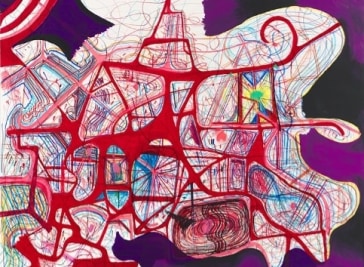
A talented New York artist who has become known for her wildly complex abstract paintings and drawings as well as her trippy, hand-built ceramics, Joanne Greenbaum utilizes color, line, and form like a Michelin-star chef uses food from the farm to whip up a tasty dish. Described as inventive, chaotic, psychological, and electrifying, her energetic paintings are defined by intuitive mark-making, which Greenbaum achieves in a variety of arresting ways. For “Scaffold,” her first solo exhibition with the gallery, the artist offers eight new, large-scale paintings—including her largest canvas to date—and five shapely, monochromatic ceramic sculptures, which are strikingly arranged in Mitchell-Innes & Nash’s spacious setting.

By embracing in her paintings the heterogeneous complexity of her situation, Greenbaum provides a metaphorical representation of the creative potential that can emerge from engaging with, rather than avoiding the contradictions inherent in our everyday experiences. Her work suggests that by embracing complexity and resisting easy resolution, we can gain deeper insights into the nature of art, life, and our own place within it. Interpreting her paintings as pictorial analogies or allegories allows for a richer, more nuanced understanding of her work, the world we live in, and our place within it.
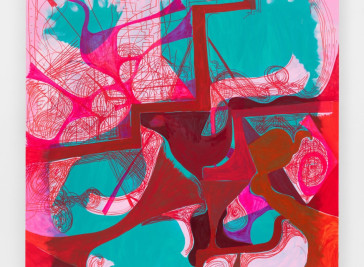
Welcome to the early edition of the Two Coats painting-centric guide to May art exhibitions in Manhattan, Brooklyn, and Queens. In Manhattan, Julia Bland has a new series of monumental woven and painted pieces at Derek Eller and Joanne Greenbaum is having her first solo at Mitchell-Innes & Nash. Mitchell-Innes & Nash / 534 W 26th St., New York, NY / Joanne Greenbaum, Scaffold / closes May 24.
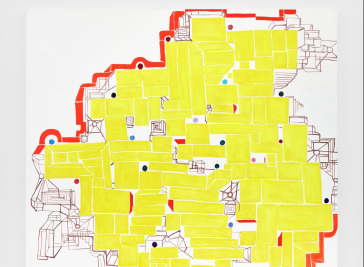
When the paintings of the blockbuster Swedish artist Hilma af Klint, who died in 1944, were first shown publicly in the 1980s, some critics argued that the works looked more like diagrams illustrating occult ideas than abstract paintings. Later audiences and critics disagreed. Tastes have changed perhaps — but so has our relationship to diagrams, as John Bender and Michael Marrinan asserted in their book “The Culture of Diagram” (2010). “Schema: World as Diagram” focuses on artists — mostly painters — who use the diagram in formal, conceptual and sometimes playful ways. Some use it to describe social, political and personal structures, such as Mike Cloud, Alan Davie, David Diao, Thomas Hirschhorn, Mark Lombardi and Loren Munk. Grids, networks and circuit boards appear in works by Alfred Jensen, Paul Pagk, Miguel Angel Ríos. Maps are a touchstone for Joanne Greenbaum and the aboriginal painters Jimmy and Angie Tchooga. More cosmic diagrams appear in paintings by Chris Martin, Karla Knight, Paul Laffoley, Trevor Winkfield and Hilma’s Ghost (the artists Dannielle Tegeder and Sharmistha Ray), who take af Klint as an inspiration.
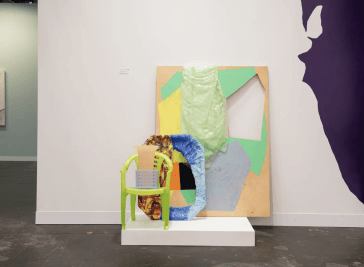
The fall art season has arrived, with its manic harvest of exhibitions, and also The Armory Show, the major art fair in New York City that shifted its schedule and venue last year, moving to this early-September date and the Javits Center. As my colleague Will Heinrich and I wandered the floor to pick these 13 favorites, we were drawn to work that seemed to move against the currents. Joanne Greenbaum’s abstract paintings — colorful and obsessive but with plenty of white space — are the eye-grabbers of this unusually coherent three-artist presentation. But Jessica Stockholder’s wonky mixed-media sculptures, sitting in the corners like mysterious forgotten projects, reward more thoughtful attention, as does the unrelenting contrast of red and blue in Brent Wadden’s loom-woven textile “paintings.” Large Rorschach blots painted directly on the booth walls by Stockholder tie it all together.
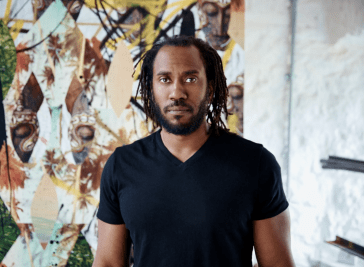
The National Academy of Design (NAD)--the venerable New York-based association of artists and architects established in 1825--has announced the induction of eight new National Academicians. The artists Julie Mehretu, Rashid Johnson, Trenton Doyle Hancock, Joanne Greenbaum, Joanna Pousette-Dart, Gary Simmons, Peter Halley and the architect Andrew Freear join more than 400 international NAD members.
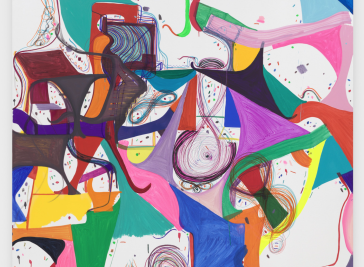
By bringing together oil paint, acrylic, water-soluble pastel, and magic marker to make her images, Greenbaum collapses the distinctions between painting and drawing; "artisanal competence" and casual mark-making; and fine art materials and cheap hobbyist supplies.
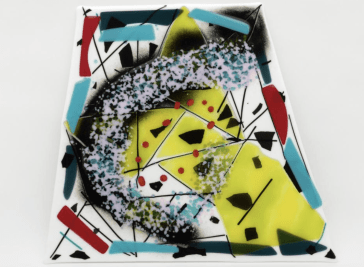
Joanne Greenbaum is a New York artist who has been painting abstract compositions for over 30 years. Her work, which ranges from playful to chaotic, cartoonish and sometimes architectural compositions, which are always a conundrum to decode. Recently, the artist has turned to making works on glass for her latest solo exhibition at Rachel Uffner Gallery in New York City, I'm Doing My Face In Magic Marker.
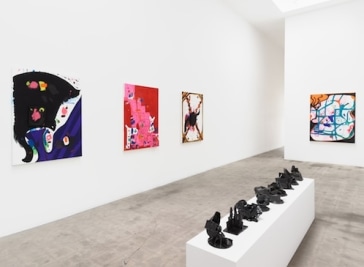
Joanne Greenbaum looks like she’s having a lot of fun at Richard Telles, where her paintings and sculptures possess an energetic whimsy that reflects their improvised creation. The paintings in particular record the wanderings of the mind and the confidence to engage in this intuitive process, but you’re left wondering what it all means. Maybe nothing. The paintings (all untitled) have a freewheeling, scribble-scrabble quality, enhanced by Greenbaum’s use of markers in addition to paint. One features a center filled with abstract doodles edged in black and overlaid with an off-kilter teal grid that segments the canvas like an aerial view of an Old World city.
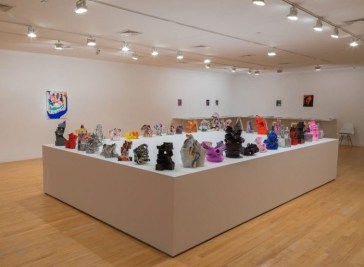
In 2018, artists and curators across the United States have been crafting brilliant exhibitions across the US, exploring themes of identity and community in innovative ways. Joanne Greenbaum’s solo exhibition at the Tufts University Art Galleries at the SMFA, curated by Dina Deitsch, caught a painter at the height of her power. Remarkably focused and articulate, Greenbaum’s work coalesces around disorder and anxiety before reforming seemingly disparate ideas into a coherent whole. Her riotous approach to mark making is only a distraction. What emerges is an entire system built around the varying languages of abstraction, both historical and current. The jittery feel of Greenbaum’s work never overwhelms, but rather reinforces her urge to push the paintings to the very limits of complexity and completeness.
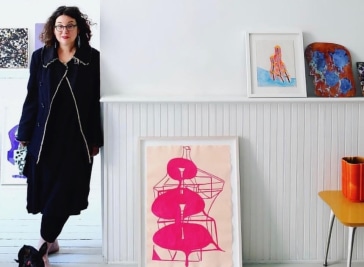
The New York-based artist Joanne Greenbaum, is well known for her abstract painting. We have the pleasure now of learning about her small sculptures and commitment to making artist books. For her latest show Caput Mortuum, on view at 56 Henry, 10 year’s worth of paintings are re-imagined as sculpture. The work runs the gamut of shapes painted in hues of saturated color, gradients, scribbles, to drips. The sculptures are stacked in an installation on a table, either encased in, or on top of, clear plexiglass boxes. Greenbaum and I spoke about how she developed her sculptural practice and how it influences her other work. "I started making sculpture in 2003 and 2004 but not in clay. I made some very small things in sculpey and some other air-dry materials. I wanted at first to understand some of the things in my paintings that resembled sculptures or fictional structures. Initially it was the bright colors of the sculpey that I responded to and then the ability to make something fast and bake it in the oven. I didn’t think it would be something I would pursue, and made these things as notes and three-dimensional drawings for the studio, to have on my table to look at, not for reference at all."
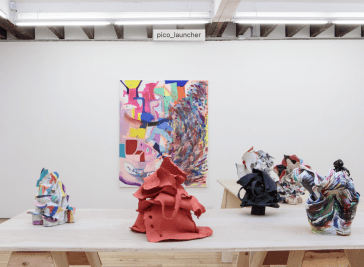
Joanne Greenbaum began making tiny sculptures out of Sculpey in 2003. The following year she enrolled in a ceramics class at Greenwich House, a non-profit community arts school in Manhattan’s West Village. The class gave her access to materials and a kiln, but she didn’t want to learn the right way to make ceramics, and wasn’t interested in making vessels. I can imagine the teacher and fellow students in her adult education class being bewildered by the non-functional, abstract pieces she made. Most of the early ceramics were relatively small, able to fit inside your hand. Now, nearly fifteen years after she enrolled in the class, Greenbaum has made larger, multipart sculptures out of porcelain, air-dried clay, and cast aluminum that liberate an odd structural beauty from folded, twisted, looping and slab-like forms. Most of the porcelain and clay sculptures are painted and drawn on in unexpected ways.
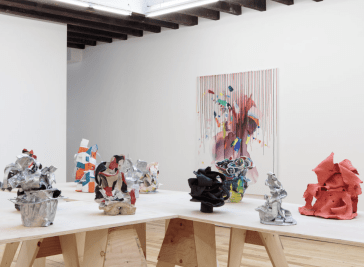
Joanne Greenbaum is operating at full capacity in her latest show at Rachel Uffner, confirming that she would have been a strong addition to the Museum of Modern Art’s recent painting survey. Her latest canvases give new meaning to Harold Rosenberg’s characterization of Abstraction Expressionist painting as “an arena in which to act” by infusing it with high-low humor instead of macho angst. Ms. Greenbaum uses paint in graphic ways, dripping it in parallel lines, in some paintings, for example, creating fringelike areas or bead-curtain backgrounds. And her drawing often builds painterly steam; in the show’s largest painting, a big cloud of pink crayon rises amid a network of electric blue shapes thatevoke an agitated Matisse cutout.
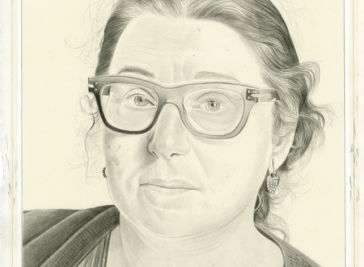
On the occasion of Joanne Greenbaum’s second one-person exhibition at Rachel Uffner Gallery (May 20 – July 1, 2016), which features both recent paintings and sculptures, Rail publisher Phong Bui paid a visit to the artist’s Tribeca studio to discuss her life and work just a day before the works were transported to the gallery for exhibition.
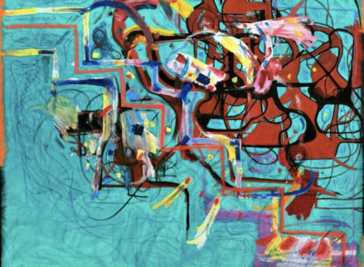
Joanne Greenbaum’s new paintings are full of stuff; very few areas are left open or unattended. In many of these new pieces, colored pencil, marker, or crayon lines run over the surface, giving the feeling of a child let loose. On first impression this creates a powerful energetic field. Once your mind has had a chance to sort out the various levels, dissonances, and cadences that form their inner structure, however, that first impression begins to recede and the order in what first appeared as a chaotic field starts to get its say.
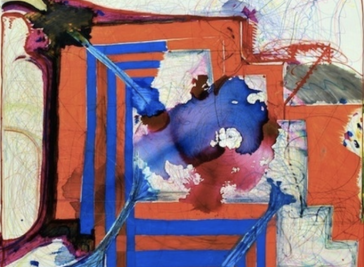
Joanne Greenbaum is an artist who lives in her studio. It is easy in her latest exhibition, the inaugural show at Rachel Uffner’s new gallery, to sense the olfactory appeal of her process—and, in fact, her practice offers another idea of the studio as a factory. Instead of Warhol’s cool Fordian mass production, the one-person Greenbaum factory creates singular, unique works of organized chaos.
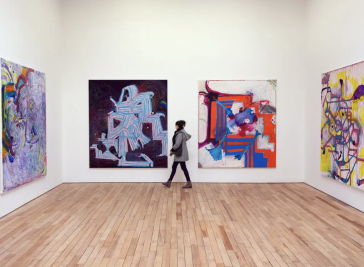
If you like painting, you must see Joanne Greenbaum’s rousing show at Rachel Uffner. Using oil and acrylic paints, pencils, crayons and various markers, Ms. Greenbaum has produced abstract compositions of infectiously joyous, improvisational panache. An underlying grid is the foundation for layered networks of curvy and straight lines, gaudy organic forms, showers of dribbled paint and areas of furious scribbling. The paintings teeter between order and chaos, harmony and dissonance, beauty and ugliness. There’s a visionary aspect, as if they were made under the guidance of some cosmic consciousness. Ms. Greenbaum, 60, has been working in this vein for nearly three decades, and she’s now operating at the top of her game.
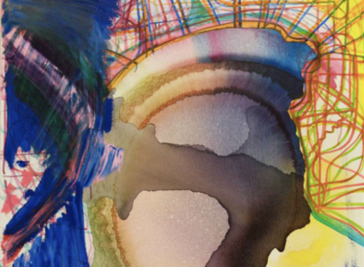
These days, when should abstraction still be dismissed as retread? It is often possible that in the act of making, ideas are transcended and subsequently reinvented. Joanne Greenbaum’s exhibition has an exuberant velocity: staggered steps, carousing curves, and vibrant colors all conspiring to reassemble as they move along. Small ceramic sculptures on a low shelf twist and turn like upended ice cream cones or like Tatlin’s leaning tower. As the architect Eladio Dieste once wrote, “The resistant virtues of . . . structures . . . depend on form.” A very simple logic, but with the inhibitions of structural engineering seemingly removed, a quasi-surreal psychological space materializes; here the incongruent becomes elegant without losing its awkwardness. Greenbaum willfully walks a tightrope, risking a fall into solipsistic drama, a descent avoided but not out of sight.
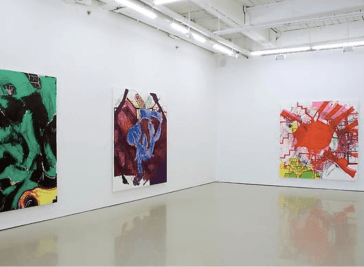
Joanne Greenbaum’s new paintings are nicely abrasive, inharmonious in color and, generally speaking, a little nuts. They make the eyes spin. Despite the show’s title “Hollywood Squares” most of these untitled canvases are compositionally askew, often dominated by jigsawed, pinwheeling spirals that unravel as they turn in on themselves, as if one shade were battling another for supremacy. This is especially true in a painting dominated by a scrum of blue-green and black, with competing incursions of red and yellow at the edges. In another painting a pink hurricanelike vortex pushes into a black field, bearing down on an infrastructure of orange, green and black that oozes with blue scribbles. The best works here emphasize dark tones, if not black, and the weight of the color works well against the thinness of the paint. What was supposed to be once-over-lightly becomes charged and impacted, pushing into the vicinity of painting without succumbing to the medium’s usual seductiveness. Ms. Greenbaum has become less tolerant of the bare white canvas that tended to make her paintings resemble large colorful drawings. These new works are something else.
